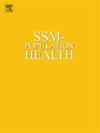Empirical design of population health strategies accounting for the distribution of population health risks
IF 3.1
2区 医学
Q1 PUBLIC, ENVIRONMENTAL & OCCUPATIONAL HEALTH
引用次数: 0
Abstract
Recent discussions in epidemiology have emphasised the need to estimate the heterogeneous effects of risk factors across the distribution of health outcomes for better aetiological understanding of the determinants of population health. We propose using quantile regression-based decomposition to expand the empirical discussion on population health intervention strategies for health equity by incorporating population homogeneity/heterogeneity in the risk–outcome association. We theorised that the ‘proportionate universalism’ approach presumes population homogeneity in the risk–outcome association with varying risk intensities, which decomposition analysis shows as the ‘covariates part’ between groups. Conversely, the ‘targeted approach’ assumes population heterogeneity in the risk–outcome association across the outcome range, which the analysis identifies as the ‘coefficients part’. Our demonstration, using a case of education-related disparity in dietary behaviours, exemplified that differences between education groups were mainly explained by the coefficients part. This finding suggests heterogeneity in their risk profiles, necessitating a ‘targeted approach’ across outcome quantiles to close the gap. The ‘proportionate universalism’ strategy could be partially applied to specific quantile segments where the covariates part remained significant as a supplementary intervention. However, simply increasing the magnitude of certain risk factors (e.g., income) showed conflicting directions between covariates and coefficients parts. Structural modifications of risk–outcome associations would therefore be more equitable. We also discuss the potential strengths and limitations of the analysis, suggesting that it may be complemented by data-driven methods using machine learning to identify discriminating risk factors for population health equity.
考虑人口健康风险分布的人口健康策略的实证设计。
流行病学最近的讨论强调,有必要估计风险因素在整个健康结果分布中的异质性影响,以便更好地从病因学角度了解人口健康的决定因素。我们建议使用基于分位数回归的分解,通过纳入风险-结果关联中的人群同质性/异质性,扩大对健康公平人群健康干预策略的实证讨论。我们的理论是,“比例普遍主义”方法假定风险-结果与不同风险强度相关的人口同质性,分解分析显示为群体之间的“协变量部分”。相反,“目标方法”假设整个结果范围内风险-结果关联的人口异质性,分析将其确定为“系数部分”。我们的论证以饮食行为中与教育相关的差异为例,说明受教育群体之间的差异主要由系数部分来解释。这一发现表明他们的风险状况存在异质性,需要在结果分位数之间采取“有针对性的方法”来缩小差距。“比例普遍性”策略可以部分应用于特定的分位数区段,其中协变量部分作为补充干预仍然显着。然而,简单地增加某些风险因素(如收入)的大小,协变量和系数部分之间的方向是相互矛盾的。因此,风险-结果关联的结构性调整将更加公平。我们还讨论了分析的潜在优势和局限性,表明可以通过使用机器学习的数据驱动方法来补充分析,以识别人口健康公平的歧视性风险因素。
本文章由计算机程序翻译,如有差异,请以英文原文为准。
求助全文
约1分钟内获得全文
求助全文
来源期刊

Ssm-Population Health
PUBLIC, ENVIRONMENTAL & OCCUPATIONAL HEALTH-
CiteScore
6.50
自引率
2.10%
发文量
298
审稿时长
101 days
期刊介绍:
SSM - Population Health. The new online only, open access, peer reviewed journal in all areas relating Social Science research to population health. SSM - Population Health shares the same Editors-in Chief and general approach to manuscripts as its sister journal, Social Science & Medicine. The journal takes a broad approach to the field especially welcoming interdisciplinary papers from across the Social Sciences and allied areas. SSM - Population Health offers an alternative outlet for work which might not be considered, or is classed as ''out of scope'' elsewhere, and prioritizes fast peer review and publication to the benefit of authors and readers. The journal welcomes all types of paper from traditional primary research articles, replication studies, short communications, methodological studies, instrument validation, opinion pieces, literature reviews, etc. SSM - Population Health also offers the opportunity to publish special issues or sections to reflect current interest and research in topical or developing areas. The journal fully supports authors wanting to present their research in an innovative fashion though the use of multimedia formats.
 求助内容:
求助内容: 应助结果提醒方式:
应助结果提醒方式:


